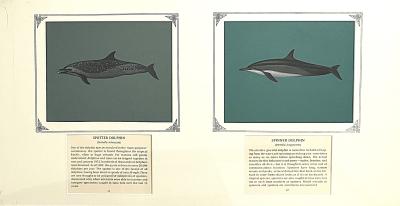PAINTINGS - (a)FRASER'S DOLPHIN & (b)WHITE BEAKED DOLPHIN
c. 19752 paintings in single framed work (a) Fraser's Dolphin - Dark gray, from the head to the tail, pale under-belly, and white blaze stripe, short beak, and small dorsal fin (17.) (b) White-beaked Dolphin - Dark grey, black body with lighter grey patches on the side and back, distinctive white beak, and tall, curved dorsal fin (18.); gouache on blue card, framed and mounted with inscription
Collection of 106 of paintings by Richard Ellis that were selected by the Smithsonian Institution to form a traveling exhibit of the marine mammals of the world. The collection was purchased by Perth businessman Kevin Parry in 1985 and donated to Whale World, now known as Albany's Historic Whaling Station.
Details
Details
FRASER'S DOLPHIN (Lagenodelphis hosei)
This species was completely unknown until 1956 when Sir Francis Fraser of the British Museum described a skeleton that was only known to have come from Borneo. In 1971, however, specimens began turning up on beaches and in tuna nets; suddenly this heretofore unknown species was identified as ranging throughout the temperate and tropical waters of the world. It was found in South Africa, Australia, and on Cocos Island in the Pacific; it has subsequently even been found in the Caribbean. While still not common, its range is extensive. Fraser's dolphin has a short snout and very small flippers; it is very wary of boats, which might account for its obscurity.
17.
WHITE-BEAKED DOLPHIN (Lagenorhynchus albirostris)
The white-beaked dolphin reaches a length of 100 feet. This North Atlantic species can sometimes be seen in schools of up to 1500 animals; it is usually shy of ships, however, and therefore has not been extensively observed in the wild. Its range sometimes overlaps that of the Atlantic white -sided (L acutus), but the two can be differentiated by the taller dorsal fi and white beak of albirostris. This dolphin can be found in the waters of Greenland, Norway, and occasionally strays as far south as Cape Cod (Mas.) and the Bay of Biscay.
18.
Verso: Smithsonian label checklist # 17,18 Packing case # 2, AWHS accession number
The paintings represent a body of work by well-known American marine conservationist, author, artist and natural historian Richard Ellis (1938-2024).
Rarity:106 of these paintings were selected by the Smithsonian Institution to form a traveling exhibit of the marine mammals of the world. All these paintings were bought by Kevin Parry and donated to Whale World
Copyright and Reference
Copyright and Reference
Albany's Historic Whaling Station
Albany's Historic Whaling Station
Other items by Richard Ellis
- PAINTINGS - (a) GANGES RIVER DOLPHIN (b)INDUS RIVER DOLPHIN
- PAINTING - RIBBON SEAL
- PAINTING - BAIKAL SEAL
- PAINTINGS - (a) BAIRD'S BEAKED WHALE (b) GOOSEBEAK WHALE
- PRINT - KILLER WHALES Publisher Proof 8/20
- PAINTINGS - (a) FIN WHALE & (b)BLUE WHALE
- PAINTING -NORTHERN FUR SEAL
- PAINTING - MEDITERRANEAN MONK SEAL
- PAINTING -BLACK DOLPHIN
- PAINTINGS - (a) MINKE WHALE & (b) BRYDE'S WHALE
- PAINTING - FRANCISCANA
- PAINTING - STELLER`S SEA LION
More items like this
- PAINTINGS - SPOTTER DOLPHIN (11) & SPINNER DOLPHIN (12)
- PAINTING - STRIPED DOLPHIN
- PAINTINGS (a) NORTHERN RIGHT DOLPHIN (b)SOUTHERN RIGHT DOLPHIN
- PAINTING - (a) INDO-PACIFIC HUMPBACK DOLPHIN & (b) ROUGH-TOOTHED DOLPHIN
- PAINTING - COMMERSON'S DOLPHIN
- PAINTING - RISSO'S DOLPHIN
- PAINTING - HEAVISIDE'S DOLPHIN
- PAINTING - HOURGLASS DOLPHIN
Other items from Albany's Historic Whaling Station
- PAINTINGS - (a) HARBOR PORPOISE (b) VAQUITA
- PAINTING - DENSE-BEAKED WHALE
- PAINTING - GRAY WHALE
- PAINTINGS - (a)PYGMY SPERM WHALE (b)DWARF SPERM WHALE
- PAINTING - SOWERBY`S BEAKED WHALE
- PAINTING -PYGMY KILLER WHALE
- PAINTINGS - (a)TRUE'S BEAKED WHALE (b) GULFSTREAM BEAKED WHALE
- PAINTINGS - (a) RIGHT WHALE & (b) BOWHEAD WHALE
- PAINTING - HUMPBACK WHALE
- PAINTING - SPERM WHALE
- PAINTING - PYGMY RIGHT WHALE
- PAINTING - KILLER WHALE

